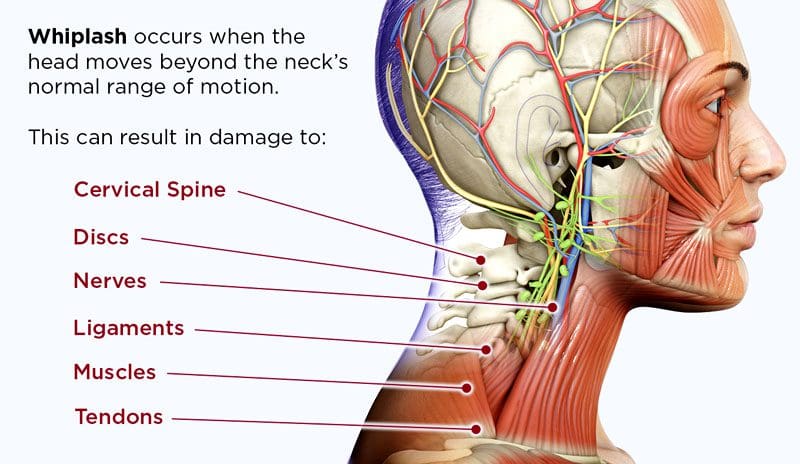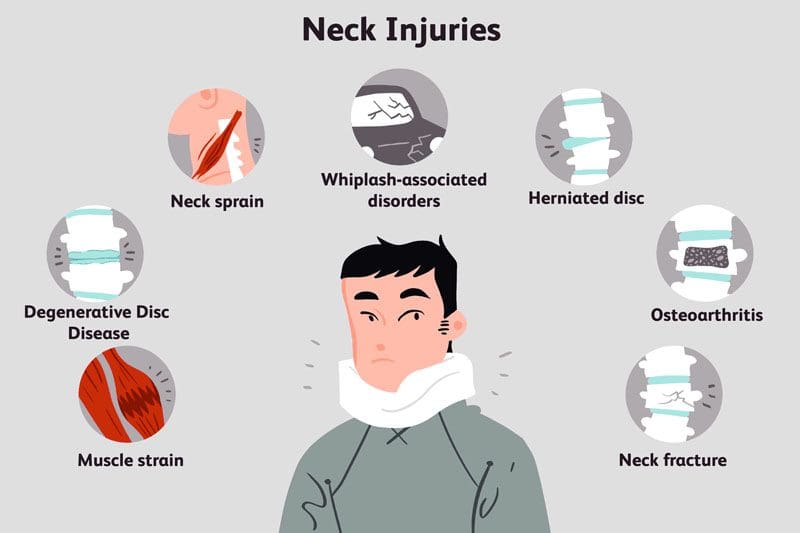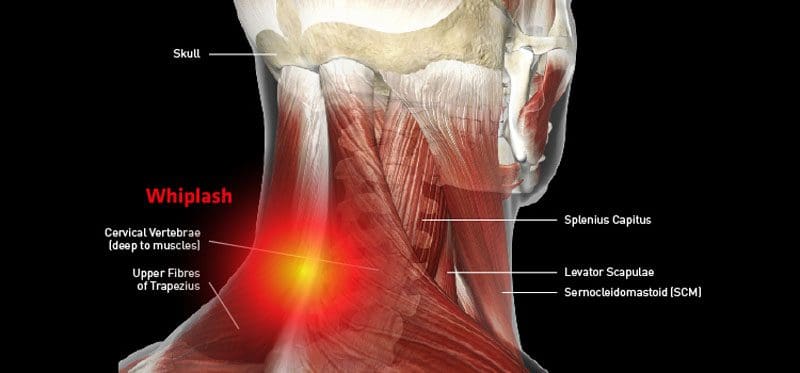Motor vehicle accidents, sports injuries, work injuries, and falls are a few causes of whiplash. It is a condition that affects over 1.5 million individuals. It can cause serious side effects that can last for months and sometimes years. If not treated, the symptoms can worsen and lead to chronic conditions and pain.

Mild Whiplash
Mild whiplash can last around three months. During this time individuals might notice other symptoms other than neck pain that includes:
- Dizziness
- Headaches
- Tinnitus
- Insomnia
- Concentration problems
In certain cases, these symptoms happen immediately or they can be delayed.

Severe Whiplash
Severe whiplash means symptoms last longer than three months. The side effects can progressively go away or may not disappear at all. Severe whiplash falls in the whiplash classification of three to four. This indicates that there is a:
- Loss of motion
- Neurological problems
- Fracture/s
Taking Time Off Work
Taking time off work for a whiplash injury depends on how severe the condition is. For mild symptoms, individuals are recommended to take about a month off to fully recover. If the condition is extreme, it could take a few years. For some individuals, the injury prevents them from working, and they have to leave their job.

Tinnitus
After a whiplash injury, some individuals develop tinnitus. This is a condition that results from the jolted ligaments and can irritate the surrounding nerves. This can cause an irritating ringing noise in the ears. How long tinnitus lasts depends on the severity of the injury. It can present every so often or could remain for several months even years.
Recovery Time
For most individuals, it takes around 4-6 weeks for a full recovery. This could last longer if the injury is not healed properly.
Pain After Six Months
Chronic whiplash can present shooting pain throughout the body and prevents individuals from living a normal life. For chronic conditions chiropractic and physical therapy are highly recommended. Treatment could be difficult at first, but improvements will follow as long as the individual stays consistent with the therapy to completely heal the injury.

Treatment Options
Rest
The first recommendation will be to rest the body. This gives the body time to recover and also prevents worsening the injury. Ice packs and heating pads can help reduce swelling and pain.
Chiropractic
Chiropractors are experts in the musculoskeletal system. They inspect the whole body looking and feeling for misalignments, knotted muscles, swollen tendons, and ligaments that were stretched/pulled beyond their normal range. Various types of adjustments can be used. The most common are flexion-distraction and instrument-assisted.
- Flexion-Distraction adjusting requires the chiropractor's hands. They feel around the problem area and press their hands to slide the joint back in place.
- Instrument-Assisted – utilizes a special tool, like an activator. The device helps the chiropractor delve deeper into the area than their hands. This helps them locate problems that could be hidden.

Anti-Inflammatory Diet
Adding more anti-inflammatory foods to the diet will reduce and alleviate inflammation and swelling. Some of these foods include:
- Avocados
- Blueberries
- Mushrooms
- Olive oil
- Salmon
- Strawberries
- Turmeric

Vitamins
A full recovery can take longer if the body lacks essential nutrients. These nutrients are what helps the body create enzymes that repair the damaged tissues, bones, tendons, etc. If the body does not have enough it will not heal properly. Essential vitamins to take for injuries include:
- B-vitamins
- Magnesium
- Vitamin D
- Zinc
These can be taken in supplement form or through food sources.
Body Composition
Muscle Loss
The body loses muscle every minute of life. This is because the muscles, like the other tissues in the body they depend on cell turnover and protein synthesis. This means that the body continually breaks down the protein in the muscles and rebuilds them. This is how the body is supposed to function and part of what keeps it alive. Skeletal muscle can be grown and developed with proper nutrition. This includes eating sufficient protein to provide the necessary amino acids and regular physical activity.
The reverse is also true becoming less physically active and the individual's diet no longer supports the development of increased muscle tissue the body enters a catabolic/tissue-reducing state known as muscle atrophy. Muscles that are partially used meaning using less than 20% of their maximum force begin to atrophy over time. Muscles that are completely unused, like when bedridden with very little movement, can degrade around 1/8th of strength per week.
Disclaimer
The information herein is not intended to replace a one-on-one relationship with a qualified health care professional, licensed physician, and is not medical advice. We encourage you to make your own health care decisions based on your research and partnership with a qualified health care professional. Our information scope is limited to chiropractic, musculoskeletal, physical medicines, wellness, sensitive health issues, functional medicine articles, topics, and discussions. We provide and present clinical collaboration with specialists from a wide array of disciplines. Each specialist is governed by their professional scope of practice and their jurisdiction of licensure. We use functional health & wellness protocols to treat and support care for the musculoskeletal system’s injuries or disorders. Our videos, posts, topics, subjects, and insights cover clinical matters, issues, and topics that relate to and support, directly or indirectly, our clinical scope of practice.* Our office has made a reasonable attempt to provide supportive citations and has identified the relevant research study or studies supporting our posts. We provide copies of supporting research studies available to regulatory boards and the public upon request. We understand that we cover matters that require an additional explanation of how it may assist in a particular care plan or treatment protocol; therefore, to further discuss the subject matter above, please feel free to ask Dr. Alex Jimenez or contact us at 915-850-0900.
Dr. Alex Jimenez DC, MSACP, CCST, IFMCP, CIFM, CTG*
email: coach@elpasofunctionalmedicine.com
phone: 915-850-0900
Licensed in Texas & New Mexico
References
Pastakia, Khushnum, and Saravana Kumar. “Acute whiplash-associated disorders (WAD).” Open access emergency medicine: OAEM vol. 3 29-32. 27 Apr. 2011, doi:10.2147/OAEM.S17853
Is Whiplash Serious: Open Access Emergency Medicine. (2011)“Acute whiplash Associated Disorders.” https://www.ncbi.nlm.nih.gov/pmc/articles/PMC4753964/
How the Neck Works: UpToDate. (2020) “Patient education: Neck pain (Beyond the Basics). https://www.uptodate.com/contents/neck-pain-beyond-the-basics




